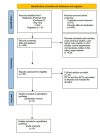Paradoxical Anti-diuretic Effects of Thiazide and Thiazide-Like Diuretics in Diabetes Insipidus: A Systematic Review
- PMID: 40370922
- PMCID: PMC12077745
- DOI: 10.7759/cureus.82247
Paradoxical Anti-diuretic Effects of Thiazide and Thiazide-Like Diuretics in Diabetes Insipidus: A Systematic Review
Abstract
Diabetes insipidus (DI) is a rare endocrine disorder predominantly characterized by polyuria, polydipsia, and dehydration, which can be defined as an excess of 3L of urine excretion in an adult over 24 hours, with the urine osmolality being less than 300 mosm/kg H2O. Increased water loss from the body can lead to significant complications, including death, from severe dehydration. Hence, timely treatment of the disease to prevent and replace the fluid loss should be instituted. Thiazide diuretics are the drugs used and act paradoxically in this particular situation. Thiazides and thiazide-like drugs have shown promising results in reducing the volume of urine output and enhancing urine osmolality in patients with nephrogenic diabetes. The mechanism by which thiazide diuretics are able to cause such a paradoxical effect is not well understood. This systematic review seeks to shed light to the details of the exact mechanism through which thiazides and thiazide-like drugs act in patients with DI, so as to bring positive changes in their overall health status and keep the water loss to a minimum. Completed clinical trials, from January 1965 to January 2025, were included in the systematic review. Risk of bias was evaluated in each of the selected articles. The revised Cochrane risk-of-bias tool for randomized trials (RoB 2) with was used for the two crossover randomized controlled trials (RCTs) and the Risk of Bias In Non-randomized Studies - of Interventions, Version 2 (ROBINS-I V2) assessment tool was used to assess the risk of bias in the non-randomized controlled trials (NRCTs) included in the systematic review. The extensive literature search through PubMed, Cochrane Central Register of Controlled Trials (CENTRAL), and Trip databases resulted in a total of 524 articles screened for this systematic review. Ultimately, only five articles, including two RCTs and three NRCTs were included in this systematic review. It is evident that the counterintuitive use of thiazide diuretics in cases of diabetes insipidus is a tried, tested, and proven method to aid in the management of fluid control in such patients, with notable improvements being identified in urine osmolality as well as urine production over a 24-hour period. The exact mechanism by which each species of thiazide diuretic specifically brings about this paradoxical effect is not well established, but the ultimate pathway by which it reduces the urine output is via proximal tubular reabsorption of water and sodium.
Keywords: antidiuretic; diabetes insipidus nephrogenic; diabetic insipidus; mode of action; neurogenic diabetes inspidus; thiazide diuretics; thiazide-like diuretics.
Copyright © 2025, Perrine et al.
Conflict of interest statement
Conflicts of interest: In compliance with the ICMJE uniform disclosure form, all authors declare the following: Payment/services info: All authors have declared that no financial support was received from any organization for the submitted work. Financial relationships: All authors have declared that they have no financial relationships at present or within the previous three years with any organizations that might have an interest in the submitted work. Other relationships: All authors have declared that there are no other relationships or activities that could appear to have influenced the submitted work.
Figures





Similar articles
-
First-line diuretics versus other classes of antihypertensive drugs for hypertension.Cochrane Database Syst Rev. 2023 Jul 13;7(7):CD008161. doi: 10.1002/14651858.CD008161.pub3. Cochrane Database Syst Rev. 2023. PMID: 37439548 Free PMC article. Review.
-
Cooperative mechanisms involved in chronic antidiuretic response to bendroflumethiazide in rats with lithium-induced nephrogenic diabetes insipidus.Acta Physiol Hung. 2014 Mar;101(1):88-102. doi: 10.1556/APhysiol.101.2014.1.10. Acta Physiol Hung. 2014. PMID: 24631797
-
Effectiveness of thiazide and thiazide-like diuretics in advanced chronic kidney disease: a systematic review and meta-analysis.Ren Fail. 2023 Dec;45(1):2163903. doi: 10.1080/0886022X.2022.2163903. Ren Fail. 2023. PMID: 36637019 Free PMC article.
-
Cooperative mechanisms of acute antidiuretic response to bendroflumethiazide in rats with lithium-induced nephrogenic diabetes insipidus.Can J Physiol Pharmacol. 2010 Dec;88(12):1191-201. doi: 10.1139/Y10-098. Can J Physiol Pharmacol. 2010. PMID: 21164566
-
A COMBINED OUTPATIENT AND INPATIENT OVERNIGHT WATER DEPRIVATION TEST IS EFFECTIVE AND SAFE IN DIAGNOSING PATIENTS WITH POLYURIA-POLYDIPSIA SYNDROME.Endocr Pract. 2018 Nov;24(11):963-972. doi: 10.4158/EP-2018-0238. Epub 2018 Aug 14. Endocr Pract. 2018. PMID: 30106630
References
Publication types
LinkOut - more resources
Full Text Sources
